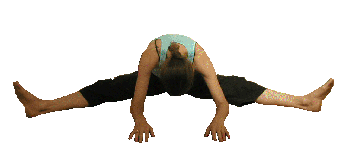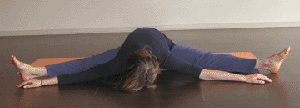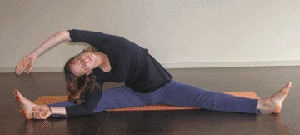
Benefits:
- Opens the hips, groin, and the back of thighs
- Provides a gentle opening to inner knees
- Stimulates the ovaries
Contra-indications:
- Can aggravate sciatica. If you have this condition, elevate the hips. Beware of hips rotating backward while seated; we want them to rotate forward.
- If you have any lower back disorders which do not allow flexion of the spine, then do not allow the spine to round: keep the back as straight as you can.
- If you have any inner knee trauma or issues, bring the legs closer together or tighten the top of the legs (the quadriceps) to engage the kneecaps.
Getting Into the Pose:
- From a sitting position, spread your legs apart until they won’t go any further. Sitting on a cushion will help tilt your hips. Fold forward, resting your weight into your hands with your arms locked straight, or rest your elbows onto a block.
 Alternatives & Options:
Alternatives & Options:
- Use bolster to raise hips.
- Can keep hands behind the back, or rest elbows on a bolster.
- Folding over one leg increases spinal and hamstring stretch.
- If the knees feel bothered, tighten the quadriceps to close the
 knee joint or bring legs closer together.
knee joint or bring legs closer together. - If hamstrings feel too tight, bend the knee(s) and place a bolster under the thigh(s).
- Legs can be 90 degrees apart to 120 degrees for advanced students. The full splits of 180 degrees is not necessary, but if you can do it, go for it.
- If you’re advanced, fold right down onto your stomach and rest your arms to the sides.

- Use a bolster under the chest, if you are close to the floor.
- If head is too heavy for the neck, support the head in hands.
- If you are stiff, bend the knees a lot! It is also okay to place the feet flat on the floor. When the knees are bent, and while sitting on a cushion, you can bend forward more easily and allow gravity to do the work.
- Can come into a twist by folding over one leg and rotating chest skyward (if advanced, hold the foot with both hands)
- Can also do a sitting up twist (which helps to stimulate the upper body meridians under the scapula).
Coming Out of the Pose:
- Use your hands to push the floor away and slowly roll up. Remember, slowly means “not fast.” This is a test! If you pop right up quickly, you are a yangster. Be a yinster and slowly come up.
- Once you are up, lean back on your hands to release the hips, tighten the leg muscles, and drag or lift your legs to bring them together. Bounce or shake out the legs. Groaning is allowed. [1]
Counter poses:
- Windshield Wipers are nice, or do a cross-legged, seated backbend
- Tabletop (aka Hammock).
Meridians & Organs Affected:
- Urinary Bladder on back of legs and on the back, and the Liver and Kidney lines through the groin and the Spleen through the inner knees.
- The twisting version will stimulate the Gall Bladder along the side of the torso.
Joints Affected:
- Hips, lower back, and knees.
Recommended Hold Times:
- Three to ten minutes;
Similar Yang Asanas:
- Upavistakonasana.
Other Notes:
- Very frustrating for beginners: the adductor muscles tug on the sitting bones, just like the hamstrings do, which causes the top of the hips to tilt backward. Persistence is required! Sitting on a bolster helps.
- Keep weight forward on the sitting bones; even tug the flesh away from the buttocks before folding forward.
- Often it is nice to spend half of the time in one variation and then add a twist for the last half of the pose.
The above video is an extract from Using Props in Yin Yoga,
which is a 50-minute video.
